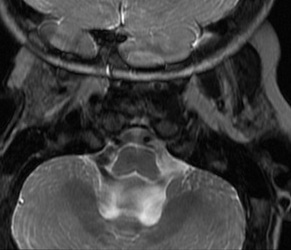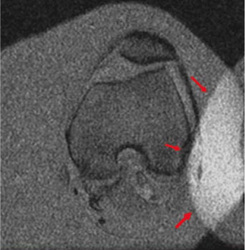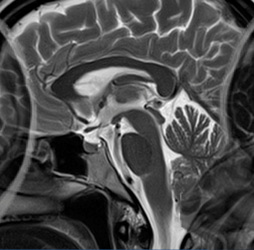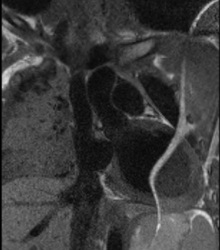Phase wrap-around is a commonly seen MR artifact that occurs whenever the dimensions of an object exceed the defined field-of-view (FOV). It is one particular manifestation of the aliasing phenomenon, described in the prior Q&A. Aliasing is the erroneous assignment of signal frequencies when the digital sampling rate is too low.
The wrap-around artifact is generally easily recognized as a folding over of anatomic parts into the area of interest. Although this phenomenon may occur in the frequency-encode direction, it is generally more severe along the phase-encode axis.
The wrap-around artifact is generally easily recognized as a folding over of anatomic parts into the area of interest. Although this phenomenon may occur in the frequency-encode direction, it is generally more severe along the phase-encode axis.
The physical basis for this phenomenon is illustrated below. Note that for each value of the phase-encoding gradient, a specific number of phase cycles is assigned to cover the field-of-view. In the first phase-encode step, for example, phase shifts of between 0° and 360° encompass the field-of-view. Parts of the object extending beyond the field-of-view possess phases less than 0° or greater than 360°. Consider, for example, the subject's left flank in the drawing; it extends outside the field-of-view and encompasses phase shifts from 361° to 450°. Since at this phase-encoding step all meaningful frequencies have been defined over the range of 0° to 360°, a phase shift of 361° will be assigned to the spatial position of 1°, and a shift of 450° will be assigned to 450°-360° = 90°. The left side of the patient's body will therefore be "wrapped around" and spatially mismapped to the opposite (right) side of the image. A similar process will wrap the patient's right side around to the left.
|
Phase wrap-around artifacts may also occur between end slices in 3D imaging. In 3DFT (volumetric) imaging, phase encoding is used to define the individual sections. If the imaged volume extends beyond the field of view in the slab-select direction, a phase wrap-around may occur between slices at the ends of the 3D partition. In the 3D head MRI study pictured right, scalp fat from the top of the head (the white oval) has wrapped around and is superimposed on tissues at the skull base.
|
Advanced Discussion (show/hide)»
No supplementary material yet. Check back soon.
References
Axel L, Morton D. Correction of phase wrapping in magnetic resonance imaging. Med Phys 1989;16:284-287.
Heiland S. From A as in aliasing to Z as in zipper: artifacts in MRI. Clin Neuroradiol 2008; 1:25-36.
Pusey E, Yoon C, Anselmo ML, Lufkin RB. Aliasing artifacts in MR imaging. Comput Med Imag Graphics 1988;12:219-224.
Zhuo J, Gullapalli RP. AAPM/RSNA physics tutorial for residents. MR artifacts, safety, and quality control. Radiographics 2006;26:275-297.
Axel L, Morton D. Correction of phase wrapping in magnetic resonance imaging. Med Phys 1989;16:284-287.
Heiland S. From A as in aliasing to Z as in zipper: artifacts in MRI. Clin Neuroradiol 2008; 1:25-36.
Pusey E, Yoon C, Anselmo ML, Lufkin RB. Aliasing artifacts in MR imaging. Comput Med Imag Graphics 1988;12:219-224.
Zhuo J, Gullapalli RP. AAPM/RSNA physics tutorial for residents. MR artifacts, safety, and quality control. Radiographics 2006;26:275-297.
Related Questions
How does phase oversampling eliminate the wrap-around artifact?
Why aren't wrap-around artifacts seen in the frequency-encode direction, too?
What is aliasing?
How does phase oversampling eliminate the wrap-around artifact?
Why aren't wrap-around artifacts seen in the frequency-encode direction, too?
What is aliasing?






